Roman & Gandhara silver from the Private Collection of Julian Sherrier @ Christie's
A Roman silver kantharos. Gandhara, circa late 1st century B.C. - early 1st century A.D.
Cast and decorated in repoussé with a deep bowl in two parts, a plain inner lining and an outer case with scenes in relief, one side with a young centaur holding a young woman in his arms, the other side with a bearded centaur grasping a struggling woman, trees with leafy tops in between and an extensive pointillé inscription in Karoshti above the bearded figure, with a turned foot separately made; 4 5/8 in. (11.7 cm.) high; 435.2 g - Estimate $150,000 - $250,000
Provenance: Private Collection, England, prior to 1979; Property from the Private Collection of Julian Sherrier
Literature: F. Baratte, East and West: A Central Asian Silver Hoard from the Parthian Era, 2002, p. 14-18, 58, fig. 1-3
Notes: Cups in precious metal with mythological subjects were often made in pairs for use at a symposium. The sources for the scenes may have been wall paintings or from literature, as in the present example, which illustrates the Centauromachy. The Centaurs were invited to the wedding feast of Peirithoos, the king of the Lapiths, during which they imbibed too much wine and their bestial side emerged. When the bride was presented, the Centaurs leapt up and attempted to abduct the Lapith women, and a fierce battle ensued during which the Centaurs were defeated and exiled from Thessaly.
The Battle of the Lapiths and Centaurs was a well-known symposium theme and became a favorite motif for vessel-makers and painters. Over time the Centauromachy came to symbolize the struggle between order and chaos, civilized peoples and barbarians. The Romans also often incorporated such stories to illustrate their cultural supremacy. However, the depiction of the abduction of the Lapith women is rare, as most illustrations of the Centauromachy are focused solely on the battle itself. For an example on which they do appear, see the south metopes of the Parthenon 12, 22, 25, 29.
For a similar example of a silver vessel, depicting the Battle of the Lapiths and Centaurs, see T. Sengelin, "Kentauroi et Kentaurides" in LIMC, vol. VIII, 2, 1997, p. 463, no. 405. For another example of this type of cup, see A. Oliver, Jr., Silver for the Gods, 1977, p. 123, cat no. 77.
The Karoshti inscription on the present example reads arsanobhadusa mogasa todirasa dra 20 10 4½ tra 1, which means "[Property] of the heir apparent's brother Moga [Maues], the todira; drakhma [wrong for sadera] 34½, trakhma 1." Richard Salomon has read and studied the inscriptions on the present and following lots, as well as examples in other collections; see R. Salomon and B. Goldman, "A Kharosthi Inscription of a Silver Goblet," Bulletin of the Asia Institute, 4, 1990, p. 149-157 . All of the inscriptions in this collection record the owner and weight of the vessel. The Karoshti script is based on Aramaic used extensively throughout the Persian Empire, suggesting the Parthian period in Gandhara immediately preceding Kushan, circa "Zeitwende" or year 1. For another example of this type with an inscription, see E. Errington, ed., The Crossroads of Asia, 1992, p. 96, fig. 99.
A silver footed bowl with mesomphalos. Gandhara, circa late 1st century B.C. - early 1st century A.D.
The shallow bowl centered by a separately made omphalos incised with concentric circles, with radiating fluting terminating in an incised line, on a low foot; 8 5/8 in. (22.4 cm.) diameter - Estimate $80,000 - $120,000
Provenance: Private Collection, England, prior to 1979; Property from the Private Collection of Julian Sherrier
Literature: F. Baratte, East and West: A Central Asian Silver Hoard from the Parthian Era, 2002, p. 33-34, fig. 13-14
Notes: The shape of this bowl is informed by a Greek precedent, the phiale mesomphalos. Such ritual libation vessels are named for the central depression on the underside that rises up into the center, allowing the bowl to be held with the palm outstretched and the middle finger reaching into the depression. With its separately attached omphalos and low foot, this bowl clearly builds on the Greek model by favoring form over function.
For a closely related example, see A. Oliver, Jr., Silver for the Gods, 1977, p. 26-27, cat. no. 3.
A silver phiale with medallion; Roman or Gandhara, circa late 1st century B.C. - early 1st century A.D.
The smooth, shallow bowl with rim folded in, centered by a separately made repoussé medallion of a bearded male figure holding a wine cup and lyre, seated on the back of a lion, a pointillé inscription in Karoshti on the exterior edge; 7½ in. (22.7 cm.) diameter; 381.5 g - Estimate $60,000 - $80,000
Provenance: Private Collection, England, prior to 1979; Property from the Private Collection of Julian Sherrier
Literature: F. Baratte, East and West: A Central Asian Silver Hoard from the Parthian Era, 2002, p. 19-21, 59, fig. 4-5
Notes: The presence of the wild beast and wine cup indicate this figure is of the Dionysian cult. A rock relief in Bisitun, Iran dated 148 B.C. shows a banqueting figured seated on a lion, see H. Luschey, "Bisutun" in Archaologischer Anzeiger, 1974, p. 122, fig. 15, and further comparables are seen in Central Asia, including the statues in the Buddhist sanctuary of Hadda, see P. Bernard, "Au-dèlé du plateu iranien: un hellénisme des confines et ses descendants indo-bactriens" in Le Grand Atlas de l'Art, 1993, p. 119-120.
Given his burly physique and beard, the figure has often been identified as Herakles. Herakles was taught to play the lyre by Linos, and when depicted with the instrument it is often in the context of the Dionysian cult or a formal performance, see "Herakles," J. Boardman and O. Palagia, LIMC, vol. IV, no. 1, pp. 810-816. For further discussion on the popularity of Herakles in Central Asia, see F. B. Flood, "Herakles, the 'Perpetual Acolyte' of the Buddha: some observations on the iconography of Vajrapani in Gandhara Art" in South Asia Archaeology, 5, 1989, p. 17-27.
The Karoshti inscription reads man[n]a sa 20 2 dra 2, which means "Weight stater 22 drakhma 2."
A silver and repousse skyphos with cranes. Roman or Gandhara, circa late 1st century B.C. - early 1st century A.D.
The solid liner with thick, straight walls, the stepped rim with a shallow groove, partially encased in a repoussé relief of cranes, each with a serpent, one with a dolphin and another with a toad behind, alternating with flowering stalks, on a separately made outsplayed ring foot, a separately cast horizontal thumb-plate attached to the casing with vertical ring handle below, the upper surface of the plate cast and engraved with foliate motifs framed by scrolling, palmettes and rosettes, with duck heads at each side along the rim; 6 in. (15.4 cm.) diameter excluding handles; 4¼ in. (10.8 cm.) high - Estimate $50,000 - $70,000
Provenance: Private Collection, England, prior to 1979; Property from the Private Collection of Julian Sherrier
Literature : F. Baratte, East and West: A Central Asian Silver Hoard from the Parthian Era, 2002, p. 23-27, fig. 7-8
Notes: For another example of this type depicting a scene with Priam and Achilles, see D.E. Strong, Greek and Roman Gold and Silver Plate, 1966, p. 136, plate 35B.
A silver skyphos with cupids. Roman or Gandhara, circa late 1st century B.C. - early 1st century A.D.
The solid cup with thick, straight walls and the stepped rim with a shallow groove, encased in a partially preserved repoussé relief of cupids, one pouring from a cup and the other holding a duck, interspersed with a column, trees and a krater, on a separately made outsplayed ring foot, a separately cast horizontal thumb plate attached to the casing with vertical ring handle below, its upper surface engraved with foliate motifs framed by scrolling, palmettes and rosettes, with duck heads at each side along the rim; 6 in. (15.2 cm.) diameter excluding handles; 4¼ in. (10.8 cm.) high - Estimate $50,000 - $70,000
Provenance: Private Collection, England, prior to 1979; Property from the Private Collection of Julian Sherrier
Literature: F. Baratte, East and West: A Central Asian Silver Hoard from the Parthian Era, 2002, p. 27-30, fig. 10-11
Notes: This skyphos originally depicted four cupids engaged in Bacchic activities, a fitting subject for a wine cup. The missing fragment of this relief is published in E. Errington, ed., Crossroads of Asia, 1992, p. 95. The fragment shows two cupids interspersed with trees. One cupid is holding a staff in the crook of his arm and a bunch of grapes, and to his left is part of tree that is continued on the present example. The second cupid has a pillar with a fluted basin on a pedestal behind him, and is facing a head of Silenus on a low pedestal. Beyond is another tree with a dog turned to the right, and the wing of the cupid that is still extant on the cup.
The handle plate ornament, with scrolling and naturalistic duck heads, derives from Early Imperial silver from Pompeii and elsewhere, and continues into the 2nd and 3rd centuries. For related ornament on a patera handle of the 1st century, from the House of Menander in Pompeii, see L. Stefanelli, L'Argento dei Romani, Vasellame da Tavola e D'Apparato, 1990, no. 148. For similar ornament on a 2nd century casserole handle found at Chatuzange in 1888, now in the British Museum, see F. Baratte, et al., Tresors D'Orfevrerie Gallo-Romains, 1989, no. 192.
A silver cup. Gandhara, circa late 1st century B.C. - early 1st century A.D.
With carinated ribbed walls, the upper portion cylindrical, the lower ovoid, with a separately made footed base, a slightly flared rim with three parallel lines incised on the inside and an extensive pointillé inscription in Karoshti on the exterior; 5 1/8 in. (13 cm.) high; 203.2 g - Estimate $50,000 - $70,000
Provenance: Private Collection, England, prior to 1979; Property from the Private Collection of Julian Sherrier
Literature: F. Baratte, East and West: A Central Asian Silver Hoard from the Parthian Era, 2002, p. 38, 59, fig. 22
Notes: This cup type is illustrated on Gandharan reliefs from Buner, see I. Kurita, Gandharan Art II, 2003, p. 186, fig. 535. This type was also found in Taxila, see J. Marshall, Taxila: An Illustrated Account of Archaeological Excavations, vol. III, 1951, pl. 183, no. 273. For a another example, see K. Tanabe, Gandharan Art from the Hirayama Collection, 2007, p. 237, fig. VI-63. fig. VI-63.
The Karoshti inscription on the present example reads anamtasena-putrasa dhraasenasa sa 10 1 1, which means "[Property] of Dhraasena, son of Anantasena, sadera 12."
A silver repoussé bowl. Gandhara, circa late 1st century B.C. - early 1st century A.D.
The hammered bowl with eight indented lobes centered by a seven-petalled lotus bordered by beading, the rim folded over, with a pointillé Karoshti inscription on the exterior; 8 in. (20.3 cm.) diameter; 267.3 g - Estimate $30,000 - $50,000
Provenance: Private Collection, England, prior to 1979; Property from the Private Collection of Julian Sherrier
Literature: F. Baratte, East and West: A Central Asian Silver Hoard from the Parthian Era, 2002, p. 33, 35, 59, fig. 15-16
Notes: The Karoshti inscription reads viradasa-putrasa hastidasasa, which means "[Property] of Hastidasa, son of Viradasa." The elongated, indented lobes and bordered lotus motif are somewhat unusual for this type of bowl. Most silver pieces favor clearly defined egg-shaped lobes with the lotus petals extending fully outwards. For similar lotiform motifs in gold from Bactria see, V. Sariandi, Bactrian Gold, 1985, p. 226, no. Ill.43, and p. 235, no. 32.
A silver cup. Gandhara, circa late 1st century B.C. - early 1st century A.D.
Carinated, the plain upper portion waisted above a fluted ovoid bowl, with three parallel lines incised on the interior rim and an extensive pointillé inscription in Karoshti on the exterior; 5 in. (12.7 cm.) high; 310.5 g - Estimate $30,000 - $55,000
Provenance: Private Collection, England, prior to 1979; Property from the Private Collection of Julian Sherrier
Literature: F. Baratte, East and West: A Central Asian Silver Hoard from the Parthian Era, 2002, p. 41, 59, fig. 23
Notes: The Karoshti inscription reads, rubea-putrasa budhavalasa sa 20 dhanea 1 1, which means "[Property] of Buddhavala, son of Rubea, sadera 20, dhanea 12." The name Rubea might also be read Rurea, the character is somehow in the middle of both outlines.
Two silver cups. Gandhara, circa late 1st century B.C. - early 1st century A.D.
Each carinated, the plain upper portion waisted above a fluted ovoid bowl, with three parallel lines incised on the interior rim, one with the bottom of the cup intact; 5 in. (12.7 cm.) high (2) - Estimate $15,000 - $20,000
Provenance: Private Collection, England, prior to 1979; Property from the Private Collection of Julian Sherrier
Literature: F. Baratte, East and West: A Central Asian Silver Hoard from the Parthian Era, 2002, pp. 41-42, fig. 21
A silver repoussé medallion. Roman or Gandhara, circa late 1st century B.C. - early 1st century A.D.
Depicting a nude male figure lying on the ground, three maenads grasping his limbs and pulling in opposing directions, trimmed with a separately made rounded border; 4 in. (10.2 cm.) diameter - Estimate $15,000 - $20,000
Provenance: Private Collection, England, prior to 1979; Property from the Private Collection of Julian Sherrier
Literature: J. Bazant and G. Berger-Doer, "Pentheus" in LIMC, vol. VII, 2, 1994, p. 254, no. 27.
F. Baratte, East and West: A Central Asian Silver Hoard from the Parthian Era, 2002, p. 21-23, fig. 6
Notes: This scene depicts Pentheus being torn apart by his mother and sisters. As the young king of Thebes, Pentheus banned the worship of Dionysus throughout his land. The maenads, female followers of the god, including his mother and sisters, continued to carry out their rites at Mount Cithaeron in defiance of his orders. The god Dionysus lured Pentheus to observe their festivities in disguise from the top of a tree, and during the frenzy the women spied Pentheus and, thinking him to be a wild animal, tore him limb from limb.
Two silver phialai. Gandhara, 1st century BC - 1st century AD
Each a plain hammered shallow bowl rising to a slightly flared rim, with a pointillé Karoshti inscription on the exterior; 9 3/8 in. (23.8 cm.) and 7½ in. (19 cm.) diameter; 416.9 g (I) and 205.1 g (II) (2) - Estimate $15,000 - $20,000
Provenance: Private Collection, England, prior to 1979; Property from the Private Collection of Julian Sherrier
Literature: F. Baratte, East and West: A Central Asian Silver Hoard from the Parthian Era, 2002, p. 45 and 59, fig. 28
Notes: The Karoshti inscriptions read theudama-putrasa budhalasa sa 20 4
dha 1, which means "[Property] of Buddhala, son of Theodornos, sadera
24.5, dhanea 1" (I) and bispela-putrasa budharaksidasa sa 10 1 1 1,
which means "[Property] of Buddharaksita, son of Bispela, sadera 13" (II).
Two silver cups. Gandhara, circa late 1st century B.C. - early 1st century A.D.
Each carinated, the plain upper portion waisted above a fluted ovoid bowl, one with the bottom of the cup intact the other with a pointillé inscription in Karoshti on the rim; 3 3/8 in. (13 cm.), the higher; 49.3 g and 135.2 g (2) - Estimate $10,000 - $15,000
Provenance: Private Collection, England, prior to 1979; Property from the Private Collection of Julian Sherrier
Literature: F. Baratte, East and West: A Central Asian Silver Hoard from the Parthian Era, 2002, pp. 38, 59, figs. 21
Notes: The Karoshti inscription reads, dhraasenasa, which means "[Property] of Dhraasena." For a pair of cups with similar iconography, from 1st century A.D. Italy, see A. Oliver, Jr., Silver for the Gods, 1977, p. 144-145, cat. nos. 96-97.
Two silver bowls. Gandhara, circa late 1st century B.C. - early 1st century A.D.
Each with flat base, gently curved sides and folded over rim; 7 in. (17.8 cm.) diameter, the larger (2) - Estimate $10,000 - $15,000
Provenance: Private Collection, England, prior to 1979; Property from the Private Collection of Julian Sherrier
Literature: F. Baratte, East and West: A Central Asian Silver Hoard from the Parthian Era, 2002, p. 45, fig. 27a-b
A silver bowl. Gandhara, circa late 1st century B.C. - early 1st century A.D.
The shallow round dish with wide flanged rim decorated with an undulating leafy vine bordered by beading and with two performations, ovolo on the overhanging lip; 5 in. (12.7 cm.) diameter - Estimate $10,000 - $15,000
Provenance: Private Collection, England, prior to 1979; Property from the Private Collection of Julian Sherrier
Literature: F. Baratte, East and West: A Central Asian Silver Hoard from the Parthian Era, 2002, p. 36, fig. 17a
Notes: The perforations on the rim indicate that this once may have been attached to a long handle and functioned as an incense burner, see J. Marshall, Taxila: An Illustrated Account of Archaeological Excavations, 1951, vol. III, pl. 184, no. 321.
Three silver cups. Gandhara, circa late 1st century B.C. - early 1st century A.D.
Each with rounded sides of varying thickness finished by a flat inward-lipped rim, two with a series of three parallel lines incised on the bottom; 5 7/8 in. (14.9 cm.) diameter, the largest (3) - Estimate $8,000 - $12,000
Provenance: Private Collection, England, prior to 1979; Property from the Private Collection of Julian Sherrier
Literature: F. Baratte, East and West: A Central Asian Silver Hoard from the Parthian Era, 2002, p. 36, fig. 26a-c
A repoussé casing. Roman or Gandhara, circa late 1st century B.C. - early 1st century A.D.
Depicting, from left to right, the sacrifice of a pig, an offering under a tree, a large krater under another tree, and a bearded figure wearing a long tunic and coat and carrying two thyrsoi and a kantharos, with three further fragments of nude male figures; 9¾ in. (24.7 cm.) wide (5) - Estimate $8,000 - $12,000
Provenance: Private Collection, England, prior to 1979; Property from the Private Collection of Julian Sherrier
Literature: F. Baratte, East and West: A Central Asian Silver Hoard from the Parthian Era, 2002, p. 31-33, fig. 12
Notes: The thrysus and kantharos, the signature accessories of Dionysus, indicate that this sacrifice is being performed under the auspices of the god of wine.
According to Strong (Greek and Roman Silver Plate, p. 114), "It seems fairly certain that by the early first century B.C. it had become fashionable to decorate drinking cups with high-relief figures scenes. As soon as high relief came into fashion the cups had to be made in two parts - an outer repoussé case and an inner plain lining which fitted closely together." The present example is likely such a case for a kantharos, and may even belong to one of the plain linings in this collection, see lots 34 and 45.
A silver ladle. Gandhara, circa late 1st century B.C. - early 1st century A.D.
The bowl with a flat base and slightly splayed rim, with two volutes flanking the cylindrical handle; 8 7/8 in. (22.5 cm.) long - Estimate $7,000 - $9,000
Provenance: Private Collection, England, prior to 1979; Property from the Private Collection of Julian Sherrier
Literature: F. Baratte, East and West: A Central Asian Silver Hoard from the Parthian Era, 2002, p. 37, fig. 18a
Three silver vessels. Gandhara, circa late 1st century B.C. - early 1st century A.D.
Including a shallow cup with thin walls, and two phiale with thick walls rising to flat rims; 7 5/8 in. (19.4 cm.) diameter, the largest (3) - Estimate $6,000 - $8,000
Provenance: Private Collection, England, prior to 1979; Property from the Private Collection of Julian Sherrier
Literature: F. Baratte, East and West: A Central Asian Silver Hoard from the Parthian Era, 2002, fig. 25a-c
Two silver sieves. Roman or Gandhara, circa late 1st century B.C. - early 1st century A.D.
One a hemispheric cup with overhanging lipped rim, perforated in two bands towards the rim; the other ovoid with scored and indented rim, the perforation arranged in concentric bands of chevrons, scrolls and waves centered by an abstract floral motif
4 3/8 in. (11 cm.) diameter, the larger (2) - Estimate $6,000 - $8,000
Provenance: Private Collection, England, prior to 1979; Property from the Private Collection of Julian Sherrier
Literature: F. Baratte, East and West: A Central Asian Silver Hoard from the Parthian Era, 2002, p. 37-38, fig. 18b-d
Notes: Each sieve may have either had a handle, or have been fitted into another vessel, see D.E. Strong, Greek and Roman Gold and Silver Plate, 1966, plate 46B.
A silver tray and cup. Gandhara, circa late 1st century B.C. - early 1st century A.D.
The tray with two circular depressions; the cup with wide, incised flat rim and overhanging lip; 2 5/8 in. (6.7 cm.) diameter, the cup; 5 1/8 in. (13 cm.) long, the tray (2) - Estimate $6,000 - $8,000
Provenance: Private Collection, England, prior to 1979; Property from the Private Collection of Julian Sherrier
Literature: F. Baratte, East and West: A Central Asian Silver Hoard from the Parthian Era, 2002, p. 39-40, fig. 20
A silver cup liner. Roman or Gandhara, circa late 1st century B.C. - early 1st century A.D.
The deep cup with rounded bottom and flared rounded rim above a series of moldings; 5¾ in. (14.6 cm.) diameter - Estimate $6,000 - $8,000
Provenance: Private Collection, England, prior to 1979; Property from the Private Collection of Julian Sherrier
Literature: F. Baratte, East and West: A Central Asian Silver Hoard from the Parthian Era, 2002, p. 36, fig. 17c
Notes: Liners of this type would have been fitted with a decorative relief in repoussé, similar to the lot 46, a footed base and handles to create a free-standing drinking vessel, similar to lot 33
Three silver aryballoi. Gandhara, circa late 1st century B.C. - early 1st century A.D.
The first with flattened sides, the second of globular shape with a cover raised on a low foot, both with evidence of soldered handles on either side, the third also globular with a narrow petalled band on the shoulder, all with waisted necks and flat rims; 2¾ in. (7 cm.), the higher (2) - Estimate $6,000 - $8,000
Provenance: Private Collection, England, prior to 1979; Property from the Private Collection of Julian Sherrier
Literature: F. Baratte, East and West: A Central Asian Silver Hoard from the Parthian Era, 2002, p. 39, fig. 19a-c
Two silver cups. Roman or Gandhara, circa late 1st century B.C. - early 1st century A.D.
Each with rounded sides finished by a flat inward-lipped rim, raised on low foot with concentric circles; one partially preserved; 4½in. (11.4 cm.) diameter, each (2)- Estimate $5,000 - $7,000
Provenance: Private Collection, England, prior to 1979; Property from the Private Collection of Julian Sherrier
Literature: F. Baratte, East and West: A Central Asian Silver Hoard from the Parthian Era, 2002, p. 36, fig. 24a-b
Notes: For a similar example with an incised foot from Gandhara, see E. Errington, ed., The Crossroads of Asia, 1992, p. 97, fig. 100.
A silver cup liner. Roman or Gandhara, circa late 1st century B.C. - early 1st century A.D.
With rounded bottom and flared rounded rim above a series of moldings; 4 5/16 in. (11.7 cm.) diameter - Estimate $5,000 - $7,000
Provenance: Private Collection, England, prior to 1979; Property from the Private Collection of Julian Sherrier
Literature: F. Baratte, East and West: A Central Asian Silver Hoard from the Parthian Era, 2002, p. 36, fig. 17b
Notes: Liners of this type would have been fitted with a decorative relief in repoussé, such as lot 46. Additionally, a footed base and handles likely would have been added to create a free-standing drinking vessel, similar to lot 33
A silver sieve. Roman or Gandhara, circa late 1st century B.C. - early 1st century A.D.
Hemispherical form with an overhanging lipped rim, the perforation arranged in concentric bands of chevrons, waves and leaf motifs centered by a flower; 4 in. (10.2 cm.) diameter - Estimate $5,000 - $7,000
Provenance: Private Collection, England, prior to 1979; Property from the Private Collection of Julian Sherrier
Literature: F. Baratte, East and West: A Central Asian Silver Hoard from the Parthian Era, 2002, p. 38, fig. 18c
Two silver aryballoi. Gandhara, circa late 1st century B.C. - early 1st century A.D.
Each with rounded sides finished by a flat inward-lipped rim, raised on low foot, with evidence of soldered heart-shaped handle-plates on either side; 2 5/8 in. (6.6 cm.) diameter, the larger (2) - Estimate $5,000 - $7,000
Provenance: Private Collection, England, prior to 1979; Property from the Private Collection of Julian Sherrier
Literature: F. Baratte, East and West: A Central Asian Silver Hoard from the Parthian Era, 2002, p. 39, fig. 19e-f
Christie's. Indian and Southeast Asian Art. 14 September 2010 New York, Rockefeller Plaza www.christies.com

/https%3A%2F%2Fprofilepics.canalblog.com%2Fprofilepics%2F1%2F0%2F100183.jpg)
/https%3A%2F%2Fstorage.canalblog.com%2F03%2F02%2F119589%2F96711876_o.jpg)
/https%3A%2F%2Fstorage.canalblog.com%2F11%2F31%2F119589%2F94773502_o.jpg)
/https%3A%2F%2Fstorage.canalblog.com%2F20%2F83%2F119589%2F94772815_o.jpg)
/https%3A%2F%2Fstorage.canalblog.com%2F26%2F72%2F119589%2F75604929_o.jpg)
/https%3A%2F%2Fstorage.canalblog.com%2F59%2F60%2F119589%2F26458628_o.jpg)

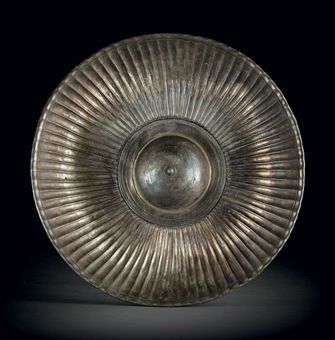

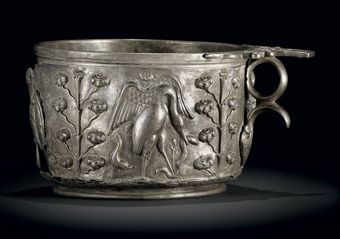







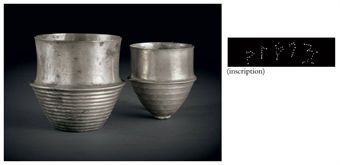

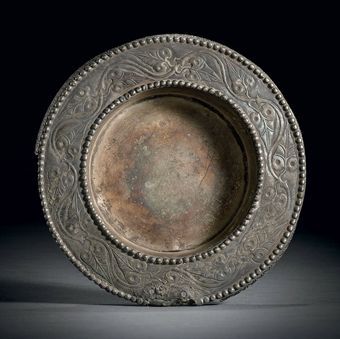





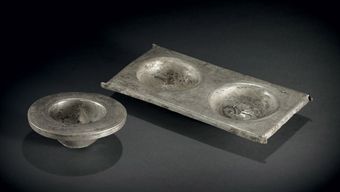








/image%2F1371349%2F20240408%2Fob_bbb9e7_2024-nyr-22642-0884-000-a-silver-hexal.jpg)
/image%2F1371349%2F20240407%2Fob_4b2318_2024-nyr-22642-0882-000-a-pair-of-silv.jpg)
/image%2F1371349%2F20240229%2Fob_c650f1_425344618-1624788374957842-51266877057.jpg)
/http%3A%2F%2Fstorage.canalblog.com%2F70%2F03%2F119589%2F129837682_o.jpg)